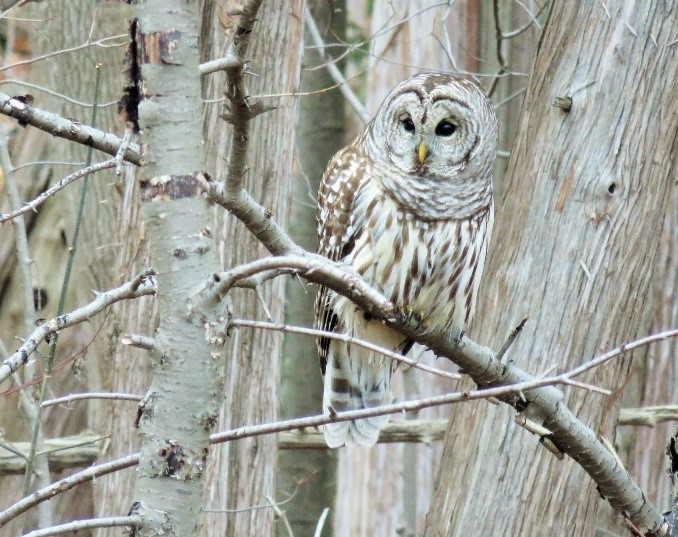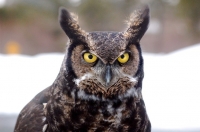The latter is what Milwaukee area residents are most likely to observe during the winter, which coincides with their mating season. The Great Horned Owl is the largest species of owl most commonly seen in Wisconsin and is the second largest in the state, next to the Snowy Owl. These owls average between two and a half to three pounds, stand up to two feet tall, and can reach an impressive wingspan of over four feet. Their large size makes them a fierce predator capable of catching a wide variety of prey, from other birds to mammals the size of a skunk.
These extremely adaptable birds live all across the United States in various climates, including urban greenspaces, making a sighting quite possible for us city-goers. If you don’t spot one, you might still hear the telltale “Who’s awake? Me, too,” echo through the night from a Great Horned Owl, calling to its monogamous mate. A male and female will call back and forth to each other in order to strengthen their bond, as well as to mark their two-mile territory. The female Great Horned Owl is larger than the male, but the male has a larger voice box, allowing for deeper hoots. The two will sing back and forth to one another in noticeably different pitches.
While it’s less likely, we may still be lucky enough to see/hear some of the other common Wisconsin owls. In dense coniferous trees, look for the Northern Saw-whet Owl, our smallest owl at about seven inches in height with a 17-inch wingspan. Preying mostly on deer mice, they can be heard singing their distinctive “too-too-too" song in the night.
 If you hear “Who cooks for you? Who cooks for you-all?” ring out, a Barred Owl is likely near. These sedentary birds prefer to nest near wetlands and rivers, having adapted to hunting aquatic life, amphibians, and invertebrates. They do not migrate and rarely even move outside of their territories, unless a Great Horned Owl moves in nearby. These medium-sized owls stand roughly 18 inches tall and have a wingspan of three to four feet.
If you hear “Who cooks for you? Who cooks for you-all?” ring out, a Barred Owl is likely near. These sedentary birds prefer to nest near wetlands and rivers, having adapted to hunting aquatic life, amphibians, and invertebrates. They do not migrate and rarely even move outside of their territories, unless a Great Horned Owl moves in nearby. These medium-sized owls stand roughly 18 inches tall and have a wingspan of three to four feet.
Lastly, in and around mixed woodlands, Eastern Screech Owls prey on large insects or small rodents with their eight-inch stature and 20-inch wingspan. Their call sounds like a descending whinny followed by a short burst of even-pitched trills.
Winters in Milwaukee are tough, but the wonders of nature still provide us with something to be admired. The Northern Saw-whet, Eastern Screech, Barred, and Great Horned Owls are all majestic, stoic creatures that find their most active time right now in the cold. So, keep your eyes open and your ears listening in the coming evenings in the hopes of hearing the mating calls of some of our most mysterious, beautiful, and thrilling birds.
Photos (in order): Great Horned Owl, Barred Owl, Eastern Screech Owl by Ethan Bott
Written by Communications Intern Ellie Rickman.
Sources:
https://www.schlitzaudubon.org/2020/11/09/owls-in-wisconsin/
https://www.allaboutbirds.org/guide/Barred_Owl/overview
https://www.allaboutbirds.org/guide/Great_Horned_Owl/overview#
https://www.schlitzaudubon.org/2019/12/23/knowing-your-neighborhood-great-horned-owl/





